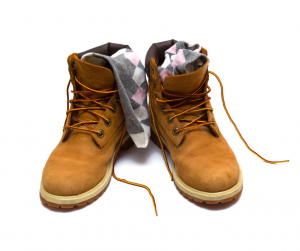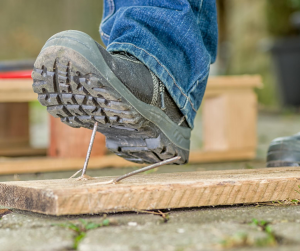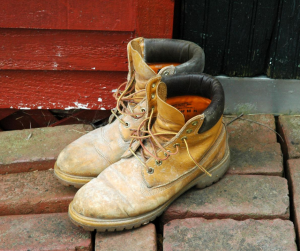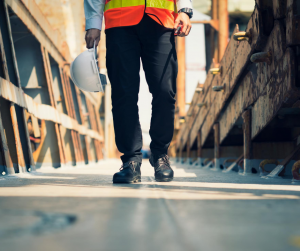
 It’s Australian Tradies National Health Month and to help support tradie health and encourage a healthy workplace through injury prevention management, our podiatrists are talking about your work boots!
It’s Australian Tradies National Health Month and to help support tradie health and encourage a healthy workplace through injury prevention management, our podiatrists are talking about your work boots!
The shoes you wear every day become the ground you walk on and can influence your risk of injury and pain. We’ve put together this safety boot fitting guide to help you use your work boots to not only protect your feet from hazards – but also keep you moving well and feeling great on your feet.
How Does Your Safety Boot Protect You, Exactly?
 Your safety boots are the main layer of protection for your feet from the hazards of your worksite. When good work boots are selected, they can help protect your while on duty and provide you with a comfortable ride to see out even the longest shift. They help provide stability to your foot and ankle on uneven ground with their high ankle support. Your safety boots may even help prevent slips and falls with their good grip in all conditions, while also protecting your skin from electrocution and burns.
Your safety boots are the main layer of protection for your feet from the hazards of your worksite. When good work boots are selected, they can help protect your while on duty and provide you with a comfortable ride to see out even the longest shift. They help provide stability to your foot and ankle on uneven ground with their high ankle support. Your safety boots may even help prevent slips and falls with their good grip in all conditions, while also protecting your skin from electrocution and burns.
Unfortunately, not all work boots are made equal. For many manufacturers, there is rightfully a key focus on compliance to the national safety standards, and comfort and support can be an unfortunate afterthought.
So, How Do You Select Better Boots For Your Feet?
We’ve put together an eight-step guide for features to look for in good work boots – so you’ll want to bookmark this one for your next shopping trip. If you have any questions about these – get in touch with your local My FootDr podiatrist!
One: What protection do you need?
Safety boots come in many types, and the best base boot for you will be one that meets the requirements of your trade and addresses the specific hazards you are regularly exposed to. Consider:
 Safety Cap – Often made of steel, the safety cap is a protective metal cover around the toe box of the boot, it ensures that the toes cannot be crushed by falling or rolling objects. Some manufacturers are now offering carbon fibre or polymer caps which provide the same level of protection but with less weight, so consider these if you find you’re getting tired, achy legs at the end of the workday
Safety Cap – Often made of steel, the safety cap is a protective metal cover around the toe box of the boot, it ensures that the toes cannot be crushed by falling or rolling objects. Some manufacturers are now offering carbon fibre or polymer caps which provide the same level of protection but with less weight, so consider these if you find you’re getting tired, achy legs at the end of the workday- Midsole Barrier – A protective layer of composite material or kevlar , present within the midsole of the shoe to better prevent sharp objects (like nails) from penetrating the bottom of the boot.
- Non-Slip Sole – Most boots have good traction soles. If you are exposed to a large amount of mud and dirt, however, consider a sole with deeper tread to increase grip
- Waterproofing – Many safety boots have basic water resistance but if you are regularly in damp or wet environments, a waterproof barrier in the boot will keep your feet dry which is going to significantly improve your comfort as well as reducing your risk of athlete’s foot, fungal nail infections, blisters and more. Consider a bellows tongue option too, to prevent water ingress from around the laces
- Electrical Protection – If you work around live electricity, ensure that you select a boot with an insulating sole to protect you against shock hazards
- Anti-Static Protection – If you work around flammable or explosive materials, such as fuel or flammable dust, you need safety boots that do not allow static electricity to build up and discharge dangerously from your boot
- Thermal Protection – If you have to work in very cold environments, having thermal protection will help prevent problems associated with blood flow restrictions to the feet – like chilblains
- Compliance – Don’t forget to tick all the boxes! Safety boots in Australia must comply with Australian Standard 2210 (AS2210) which should be clearly marked on their label
Two: Weight matters
Modern materials mean that a safety boot doesn’t need to be heavy to get the job done. Lighter boots will put less stress on the muscles and joints in your feet and legs during the day, which will help with end-of-day aches and tiredness. If you’re prone to this fatigue, we recommend selecting a lighter boot that has the protection you need.
Three: The sole
 Check the sole of any prospective safety boot. You want to see some flex at the toe – this is important to allow you to walk normally and should mimic the location of where your forefoot would bend at the ball of your foot. There shouldn’t be any flex in the rest of the sole, and if your existing boots flex in the sole other than at the toes due to wear over time, this is a good indicator it’s time to replace them.
Check the sole of any prospective safety boot. You want to see some flex at the toe – this is important to allow you to walk normally and should mimic the location of where your forefoot would bend at the ball of your foot. There shouldn’t be any flex in the rest of the sole, and if your existing boots flex in the sole other than at the toes due to wear over time, this is a good indicator it’s time to replace them.
Four: Get the right fit, every time
You’ve heard the saying ‘measure twice, cut once’, it applies to boot fitting as well! Just because you’re a size nine running shoe doesn’t mean you should buy a size nine safety boot off the shelf (or the web), without trying them on first. Measure your foot in the store and remember that different brands have variations in sizing. We highly recommend buying your work boot at the end of the day as your feet can swell as the day progresses – and you can bet they will during a hot day at work.
When trying your boot on, your toes shouldn’t touch the end. Slide your foot forward until your toes do touch the cap and see how much space there is between your heel and the back of the boot – it should be about a finger’s width. Next, check the width of your foot in the boot, both across the middle and at the toes. Again, width differs between brands, so don’t be afraid to shop around. Ideally, your foot should feel snug but not under any pressure from the side of the boot.
Pro tip: Some brands have released specific women’s safety boot ranges that are designed to suit the slightly different, and often narrower, shape of women’s feet. For example, see ‘Steel Blue – Ladies Fit’ – and check if the store you’re headed to has the right range
Five: Fasteners
Once you have the right size, do up the laces, zips or other fastening mechanisms. The boot should hold your foot well in position and prevent it from slipping forwards, yet not be so tight that it feels painful or restrictive. We recommend lace-up boots, or a combination of laces and zip-ups over elastics. They’re not as adjustable, so can’t be matched perfectly to your feet. Laces also provided the highest level of ankle support and ankle stability should always be a priority.
Six: Arch support
The arch support of your boot needs to be aligned with your foot type and any specific requirements, especially if you have a history of foot injuries. This is where we highly recommend having a pair of custom foot orthotics created specifically for your work boots, from a scan of your feet paired with your foot biomechanics and other characteristics.
Be careful when selecting boots with an unspecified level of arch support. If you have a neutral or supinated (rolled out) foot type, having a boot with in-built arch support may push you further out and leave you feeling less stable at the ankle while having a greater risk of ankle sprains.
Six: The good feels
Your feet are going to spend a lot of time in these boots, so it’s important to get something well-made. Check that the internal seams of the boot are smooth and won’t rub against or irritate your foot. Also make sure there are no sharp edges around the toe cap.
Seven: Break them in well
All shoes require some ‘breaking in’ and the amount of time required will vary depending on the materials used in the construction. Check the manufacturer’s recommendations for breaking in your boot and make sure you follow them – otherwise, you’re almost certainly going to get some blisters and pain on that first day of wear. Wear them around the house for an hour or so, increasing by an hour each day, until you can wear them for an entire day comfortably.
Eight: Socks matter
Bring the right thickness of socks to your fitting, when you’re ready for purchase. Fitting your boots with a pair of thin socks – or worse, the sheer disposable sockettes that many stores have, will give you an inaccurate representation of how your feet will feel in the boots – and how much space you have.
If you don’t have good work socks, invest in a thicker pair that will provide greater comfort and shock absorption. Avoid cotton – synthetic fibres will do a better job of keeping your feet dry and provide good support. Merino wool is a great alternative which is naturally antimicrobial, so may help reduce foot odour, and will keep your feet reasonably dry and very warm.
… And If You’re Getting Pains Or Niggles In Your Work Boots?
If you’re currently battling foot pain, aches or discomfort at the end of a long day in your work boots, come in and see your local My Foot Dr podiatrist – we’d love to help. We understand how important it is for you to be able to be comfortable at work – and stay pain and injury-free.
Book your appointment by calling us on 1800 FOOTDR or booking your appointment online here. You can find your nearest My FootDr podiatry centre here.


